Phytochemical Profiling and Antiviral Activity of Green Sustainable Nanoparticles Derived from Maesa indica (Roxb.) Sweet against Human Coronavirus 229E
Abstract
1. Introduction
2. Results and Discussion
2.1. Characterization of ZnO Nanoparticles
2.1.1. FT-IR Analysis of Nano-ZnO and ME
2.1.2. Zeta Potential ZnO NPs and DLS
2.1.3. UV Analysis
2.1.4. Transmission Electron Microscopy (TEM)
2.1.5. XRD Analysis
2.2. LC-ESI-MS/MS-MRM Analyses
2.3. Anti−Coronavirus 229E Activities of ME, ZnO NPs and ZnO NPs Combined with ME
3. Materials and Methods
3.1. Plant Materials
3.2. Extraction of Plant Materials
3.3. ZnO NPs Green Biosynthesis
3.4. Description of Nano-ZnO Particles
3.5. LC−ESI−MS/MS−MRM Profiling of Polyphenols
Multiple-Reaction Monitoring (MRM) Mode
- (1)
- Capillary temperature of 400 °C;
- (2)
- Ion Spray voltage: 4500 for positive mode and −4500 for negative mode;
- (3)
- Curtain gas: 25 psi;
- (4)
- Nebulizer gas at 55 psi with a declustering potential: 50;
- (5)
- Collision energy: 25;
- (6)
- Collision energy spread: 10.
3.6. Antiviral Activity Assay
4. Conclusions
Author Contributions
Funding
Institutional Review Board Statement
Informed Consent Statement
Data Availability Statement
Conflicts of Interest
References
- Moore, J.E.; Mascarenhas, A.; Bain, J.; Straus, S.E. Developing a comprehensive definition of sustainability. Implement. Sci. 2017, 12, 110. [Google Scholar] [CrossRef] [PubMed]
- Selim, Y.A.; Azb, M.A.; Ragab, I.; Abd El-Azim, M.H.M. Green synthesis of zinc oxide nanoparticles using aqueous extract of Deverra tortuosa and their cytotoxic activities. Sci. Rep. 2020, 10, 3445. [Google Scholar] [CrossRef] [PubMed]
- Bajpe, S.N.; Marulasiddaswamy, K.M.; Ramu, R.; Badiger, A.S.; Rudrappa, M.K.; Kini, R.K. Biotechnology. Assessing DNA barcodes species discriminating ability and phylogenetic relation within Embelia species. J. Appl. Biol. Biotechnol. 2022, 10, 22–27. [Google Scholar] [CrossRef]
- Devarajan, N.; Ramalingam, S.; Subramaniam, S.M. Gas chromatography mass spectroscopy chromatogram and antimicrobial activity of leaf extracts of Blepharis maderaspatensis and Maesa indica. J. Herbs Spices Med. Plants 2015, 21, 267–282. [Google Scholar] [CrossRef]
- Shanmugam, S.; Baby, J.P.; Chandran, R.; Thankarajan, S.; Thangaraj, P. Maesa indica: A nutritional wild berry rich in polyphenols with special attention to radical scavenging and inhibition of key enzymes, α-amylase and α-glucosidase. J. Food Sci. Technol. 2016, 53, 2957–2965. [Google Scholar] [CrossRef]
- Ahn, E.-Y.; Park, Y. Anticancer prospects of silver nanoparticles green-synthesized by plant extracts. Mater. Sci. Eng. C 2020, 116, 111253. [Google Scholar] [CrossRef]
- Yadavalli, T.; Shukla, D. Role of metal and metal oxide nanoparticles as diagnostic and therapeutic tools for highly prevalent viral infections. Nanomed. Nanotechnol. Biol. Med. 2017, 13, 219–230. [Google Scholar] [CrossRef]
- Lee, W.G.; Kim, Y.-G.; Chung, B.G.; Demirci, U.; Khademhosseini, A. Nano/Microfluidics for diagnosis of infectious diseases in developing countries. Adv. Drug Deliv. Rev. 2010, 62, 449–457. [Google Scholar] [CrossRef]
- Madhumitha, G.; Elango, G.; Roopan, S.M. Biotechnological aspects of ZnO nanoparticles: Overview on synthesis and its applications. Appl. Microbiol. Biotechnol. 2016, 100, 571–581. [Google Scholar] [CrossRef]
- Alqahtani, A.A.; El Raey, M.A.; Abdelsalam, E.; Ibrahim, A.M.; Alqahtani, O.; Torky, Z.A.; Attia, H.G. The Biosynthesized Zinc Oxide Nanoparticles’ Antiviral Activity in Combination with Pelargonium zonale Extract against the Human Corona 229E Virus. Molecules 2022, 27, 8362. [Google Scholar] [CrossRef] [PubMed]
- Kaur, N.; Singh, R.; Dar, Z.; Bijarnia, R.K.; Dhingra, N.; Kaur, T. Genetic comparison among various coronavirus strains for the identification of potential vaccine targets of SARS-CoV-2. Infect. Genet. Evol. 2021, 89, 104490. [Google Scholar] [CrossRef] [PubMed]
- Safari, F.; Afarid, M.; Rastegari, B.; Borhani-Haghighi, A.; Barekati-Mowahed, M.; Behzad-Behbahani, A. CRISPR systems: Novel approaches for detection and combating COVID-19. Virus Res. 2021, 294, 198282. [Google Scholar] [CrossRef] [PubMed]
- Malik, Y.A. Properties of coronavirus and SARS-CoV-2. Malays. J. Pathol. 2020, 42, 3–11. [Google Scholar]
- Johansson, M.A.; Quandelacy, T.M.; Kada, S.; Prasad, P.V.; Steele, M.; Brooks, J.T.; Slayton, R.B.; Biggerstaff, M.; Butler, J.C. SARS-CoV-2 transmission from people without COVID-19 symptoms. JAMA Netw. 2021, 4, e2035057. [Google Scholar] [CrossRef] [PubMed]
- Polack, F.P.; Thomas, S.J.; Kitchin, N.; Absalon, J.; Gurtman, A.; Lockhart, S.; Perez, J.L.; Pérez Marc, G.; Moreira, E.D.; Zerbini, C.; et al. Safety and efficacy of the BNT162b2 mRNA COVID-19 vaccine. N. Engl. J. Med. 2020, 383, 2603–2615. [Google Scholar] [CrossRef]
- Ghaffari, H.; Tavakoli, A.; Moradi, A.; Tabarraei, A.; Bokharaei-Salim, F.; Zahmatkeshan, M.; Farahmand, M.; Javanmard, D.; Kiani, S.J.; Esghaei, M. Inhibition of H1N1 influenza virus infection by zinc oxide nanoparticles: Another emerging application of nanomedicine. J. Biomed. Sci. 2019, 26, 70. [Google Scholar] [CrossRef]
- Gupta, J.; Irfan, M.; Ramgir, N.; Muthe, K.; Debnath, A.; Ansari, S.; Gandhi, J.; Ranjith-Kumar, C.; Surjit, M. Antiviral Activity of Zinc Oxide Nanoparticles and Tetrapods against the Hepatitis E and Hepatitis C Viruses. Front. Microbiol. 2022, 13, 881595. [Google Scholar] [CrossRef]
- Korant, B.; Kauer, J.; Butterworth, B. Zinc ions inhibit replication of rhinoviruses. Nature 1974, 248, 588–590. [Google Scholar] [CrossRef]
- Melk, M.M.; El-Hawary, S.S.; Melek, F.R.; Saleh, D.O.; Ali, O.M.; El Raey, M.A.; Selim, N.M. Antiviral activity of zinc oxide nanoparticles mediated by Plumbago indica L. Extract against herpes simplex virus type 1 (HSV-1). Int. J. Nanomed. 2021, 16, 8221–8233. [Google Scholar] [CrossRef]
- Sportelli, M.C.; Izzi, M.; Loconsole, D.; Sallustio, A.; Picca, R.A.; Felici, R.; Chironna, M.; Cioffi, N. On the efficacy of ZnO nanostructures against SARS-CoV-2. Int. J. Mol. Sci. 2022, 23, 3040. [Google Scholar] [CrossRef]
- Olech, M.; Nowak, R.; Ivanova, D.; Tashev, A.; Boyadzhieva, S.; Kalotova, G.; Angelov, G.; Gawlik-Dziki, U. LC-ESI-MS/MS-MRM profiling of polyphenols and antioxidant activity evaluation of junipers of different origin. Appl. Sci. 2020, 10, 8921. [Google Scholar] [CrossRef]
- Melk, M.M.; El-Hawary, S.S.; Melek, F.R.; Saleh, D.O.; Ali, O.M.; El Raey, M.A.; Selim, N.M. Nano zinc oxide green-synthesized from plumbago auriculata lam. alcoholic extract. Plants 2021, 10, 2447. [Google Scholar] [CrossRef] [PubMed]
- Fakhari, S.; Jamzad, M.; Kabiri Fard, H.K. Green synthesis of zinc oxide nanoparticles: A comparison. Green Chem. Lett. Rev. 2019, 12, 19–24. [Google Scholar] [CrossRef]
- Srinivasan, N.; Rangasami, C.; Kannan, J.C. Synthesis structure and optical properties of zinc oxide nanoparticles. Int. J. Appl. Eng. Res. 2015, 10, 343–345. [Google Scholar]
- Bigdeli, F.; Morsali, A.; Retailleau, P. Syntheses and characterization of different zinc (II) oxide nano-structures from direct thermal decomposition of 1D coordination polymers. Polyhedron 2010, 29, 801–806. [Google Scholar] [CrossRef]
- Wolf, M.F.; Coleman, K.P.; Rankin, E.A.; Lewerenz, G.M. In vitro assessment of cell and tissue compatibility. In Biomaterials Science; Elsevier: Amsterdam, The Netherlands, 2020; pp. 851–868. [Google Scholar]
- Jassim, S.A.; Naji, M.A. Novel antiviral agents: A medicinal plant perspective. J. Appl. Microbiol. 2003, 95, 412–427. [Google Scholar] [CrossRef]
- Apers, S.; Baronikova, S.; Sindambiwe, J.-B.; Witvrouw, M.; De Clercq, E.; Berghe, D.V.; Van Marck, E.; Vlietinck, A.; Pieters, L. Antiviral, haemolytic and molluscicidal activities of triterpenoid saponins from Maesa lanceolata: Establishment of structure-activity relationships. Planta Medica 2001, 67, 528–532. [Google Scholar] [CrossRef]
- Fu’ad, A. Mengungkap Keanekaragaman Kandungan Kimiawi Dan Bioaktivitas Dalam Bahan Obat Alami; Airlangga University: Surabaya, Indonesia, 2017. [Google Scholar]
- Murthy, S.K. Nanoparticles in modern medicine: State of the art and future challenges. Int. J. Nanomed. 2007, 2, 129–141. [Google Scholar]
- Alrabayah, I.N.; Elhawary, S.S.; Kandil, Z.A.; El-Kadder, E.M.A.; Moemen, Y.S.; Saleh, A.M.; El Raey, M.A. Green Synthesized Zinc Oxide Nanoparticles Based on Cestrum diurnum L. of Potential Antiviral Activity against Human Corona 229-E Virus. Molecules 2022, 28, 266. [Google Scholar] [CrossRef] [PubMed]
- Vuolo, M.M.; Lima, V.S.; Junior, M.R.M. Phenolic compounds: Structure, classification, and antioxidant power. In Bioactive Compounds; Elsevier: Amsterdam, The Netherlands, 2019; pp. 33–50. [Google Scholar]
- Asres, K.; Seyoum, A.; Veeresham, C.; Bucar, F.; Gibbons, S. Naturally derived anti-HIV agents. Phytother.Res. Int. J. Devoted Pharmacol. Toxicol. Eval. Nat. Prod. Deriv. 2005, 19, 557–581. [Google Scholar] [CrossRef]
- Higa, S.; Hirano, T.; Kotani, M.; Matsumoto, M.; Fujita, A.; Suemura, M.; Kawase, I.; Tanaka, T. Fisetin, a flavonol, inhibits TH2-type cytokine production by activated human basophils. J. Allergy Clin. Immunol. 2003, 111, 1299–1306. [Google Scholar] [CrossRef] [PubMed]
- Lalani, S.; Poh, C.L. Flavonoids as antiviral agents for Enterovirus A71 (EV-A71). Viruses 2020, 12, 184. [Google Scholar] [CrossRef] [PubMed]
- Godinho, P.I.; Soengas, R.G.; Silva, V.L. Therapeutic potential of glycosyl flavonoids as anti-coronaviral agents. Pharmaceuticals 2021, 14, 546. [Google Scholar] [CrossRef] [PubMed]
- Wang, W.-X.; Zhang, Y.-R.; Luo, S.-Y.; Zhang, Y.-S.; Zhang, Y.; Tang, C. Chlorogenic acid, a natural product as potential inhibitor of COVID-19: Virtual screening experiment based on network pharmacology and molecular docking. Nat. Prod. Res. 2022, 36, 2580–2584. [Google Scholar] [CrossRef]
- Silva-Beltrán, N.P.; Galvéz-Ruíz, J.C.; Ikner, L.A.; Umsza-Guez, M.A.; de Paula Castro, T.L.; Gerba, C.P. In vitro antiviral effect of Mexican and Brazilian propolis and phenolic compounds against human coronavirus 229E. Int. J. Environ. Health Res. 2022. [Google Scholar] [CrossRef]
- Shah, M.A.; Rasul, A.; Yousaf, R.; Haris, M.; Faheem, H.I.; Hamid, A.; Khan, H.; Khan, A.H.; Aschner, M.; Batiha, G.E. Combination of natural antivirals and potent immune invigorators: A natural remedy to combat COVID-19. Phytother. Res. 2021, 35, 6530–6551. [Google Scholar] [CrossRef]
- Shaldam, M.A.; Yahya, G.; Mohamed, N.H.; Abdel-Daim, M.M.; Al Naggar, Y. In silico screening of potent bioactive compounds from honeybee products against COVID-19 target enzymes. Environ. Sci. Pollut. Res. 2021, 28, 40507–40514. [Google Scholar] [CrossRef]
- Khan, F.; Bamunuarachchi, N.I.; Tabassum, N.; Kim, Y.-M. Caffeic acid and its derivatives: Antimicrobial drugs toward microbial pathogens. J. Agric. Food Chem. 2021, 69, 2979–3004. [Google Scholar] [CrossRef]
- Al-Zahrani, A.A. Rutin as a promising inhibitor of main protease and other protein targets of COVID-19: In silico study. Nat. Prod. Commun. 2020, 15, 1934578X20953951. [Google Scholar]
- Abbas, H.A.; Salama, A.M.; El-Toumy, S.A.; Salama, A.A.A.; Tadros, S.H.; El Gedaily, R.A. Novel Neuroprotective Potential of Bunchosia armeniaca (Cav.) DC against Lipopolysaccharide Induced Alzheimer’s Disease in Mice. Plants 2022, 11, 1792. [Google Scholar] [CrossRef]
- Attia, G.H.; Alyami, H.S.; Orabi, M.A.; Gaara, A.H.; El Raey, M.A. Antimicrobial activity of silver and zinc nanoparticles mediated by eggplant green Calyx. Int. J. Pharmacol. 2020, 16, 236–243. [Google Scholar] [CrossRef]
- AbouAitah, K.; Allayh, A.K.; Wojnarowicz, J.; Shaker, Y.M.; Swiderska-Sroda, A.; Lojkowski, W. Nanoformulation composed of ellagic acid and functionalized zinc oxide nanoparticles inactivates DNA and RNA viruses. Pharmaceutics 2021, 13, 2174. [Google Scholar] [CrossRef] [PubMed]
- Pauwels, R.; Balzarini, J.; Baba, M.; Snoeck, R.; Schols, D.; Herdewijn, P.; Desmyter, J.; De Clercq, E. Rapid and automated tetrazolium-based colorimetric assay for the detection of anti-HIV compounds. J. Virol. Methods 1988, 20, 309–321. [Google Scholar] [CrossRef] [PubMed]
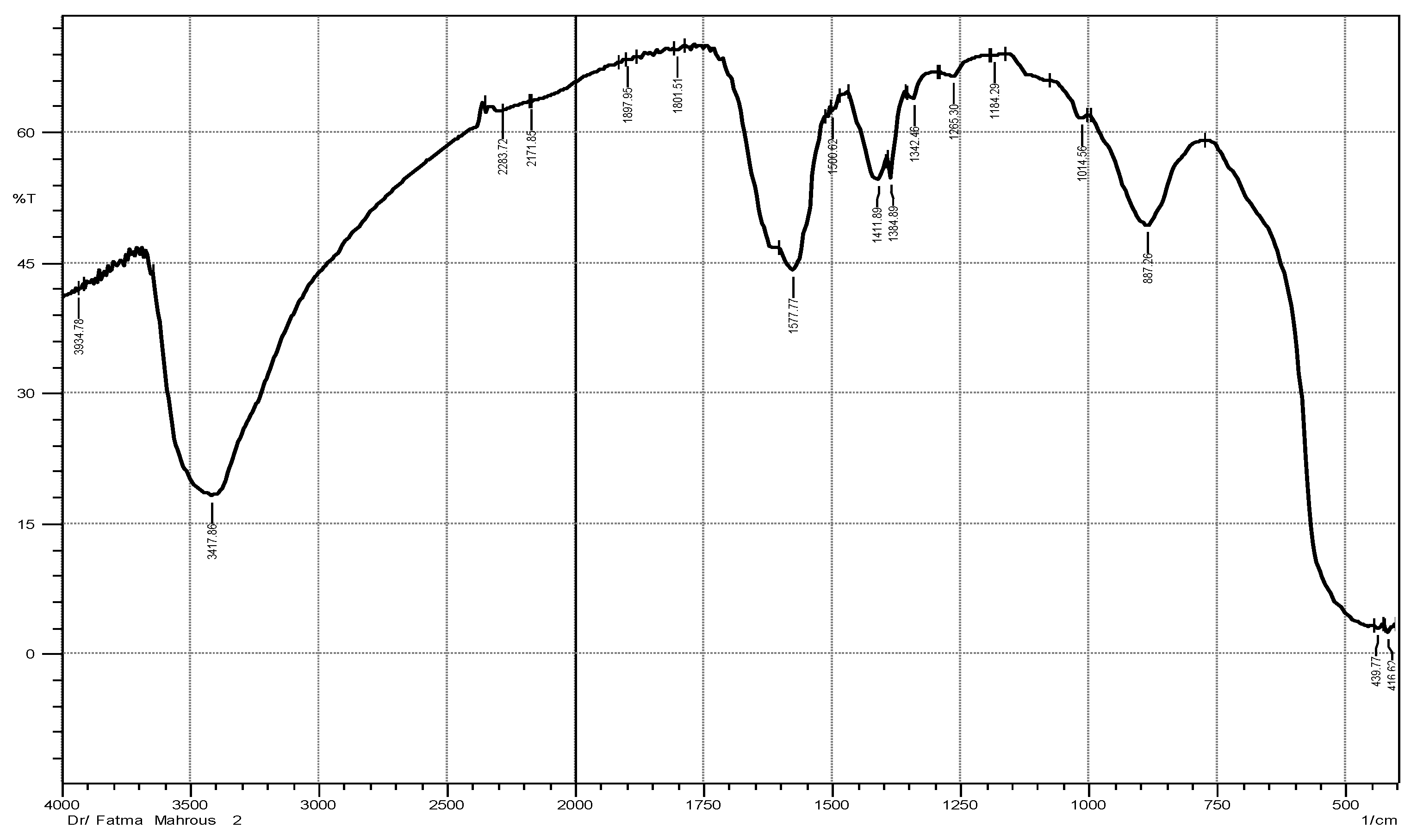
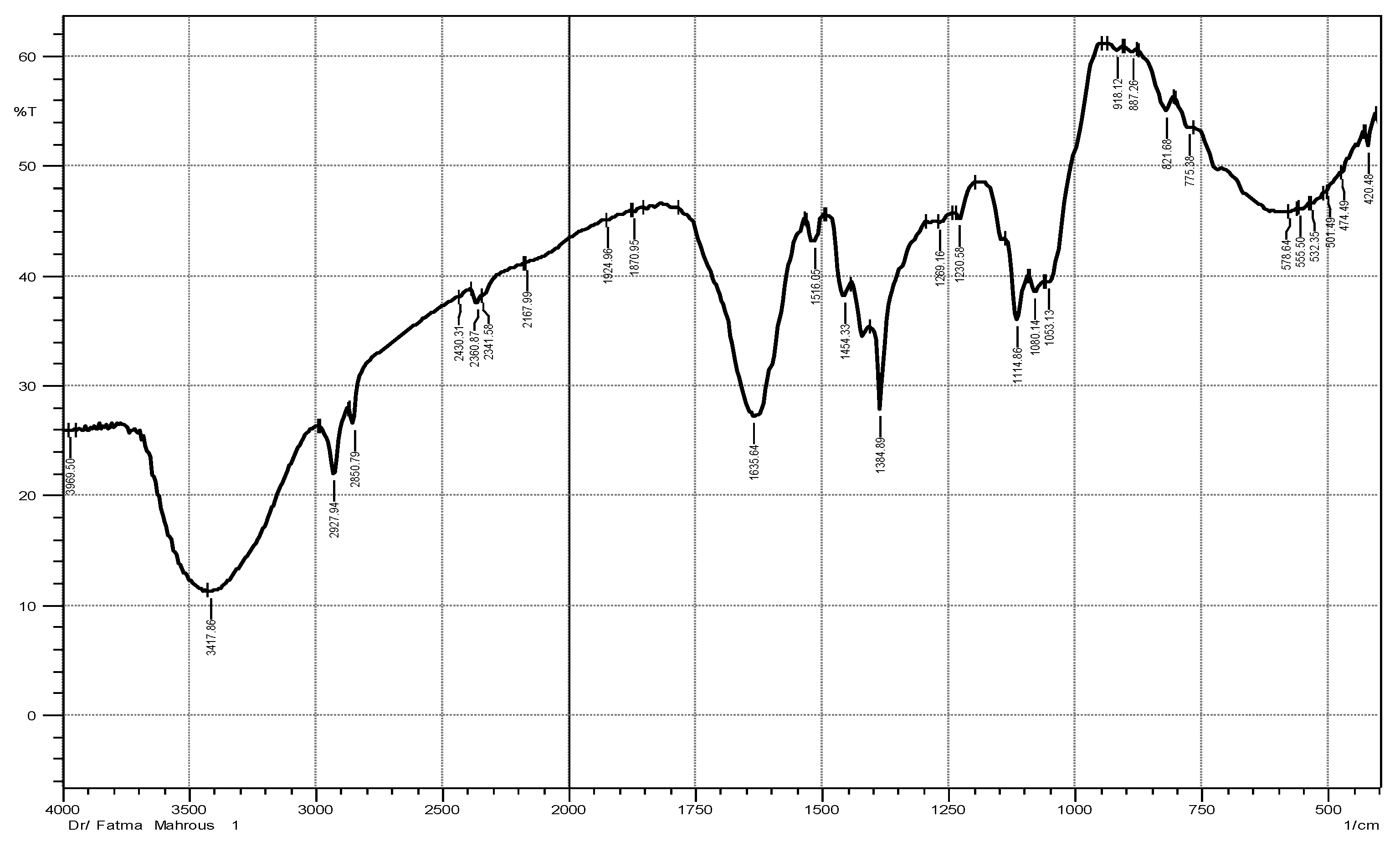

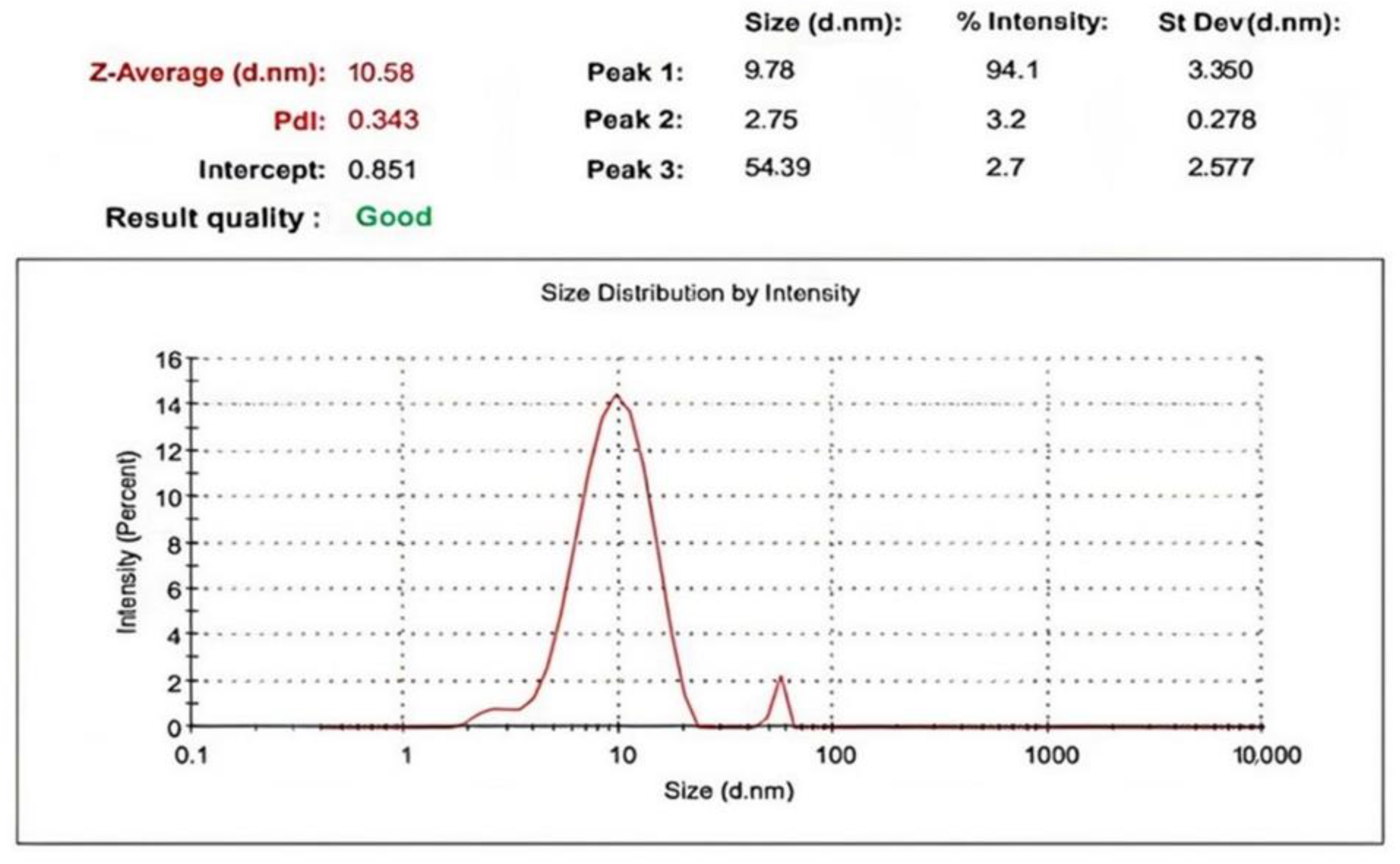
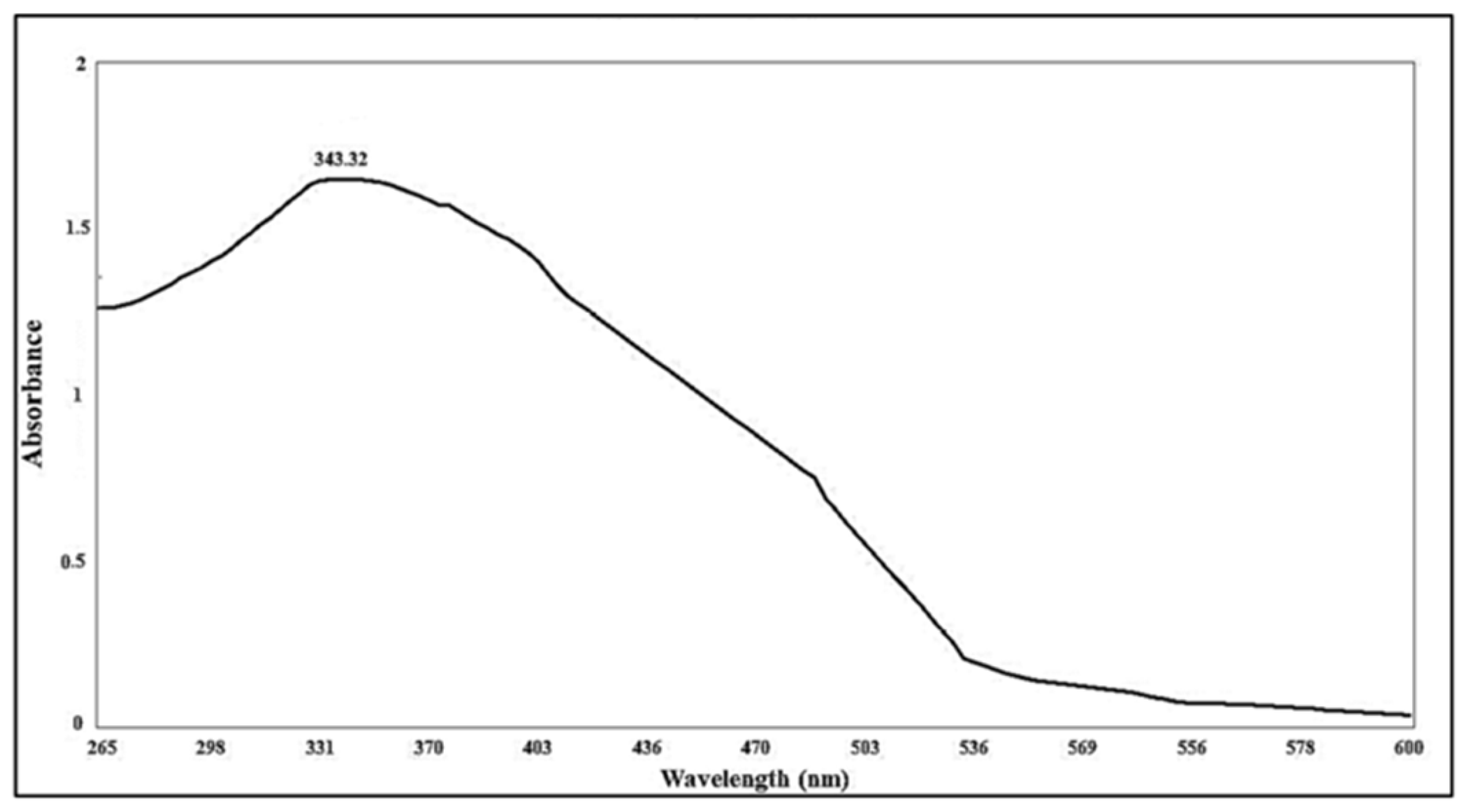
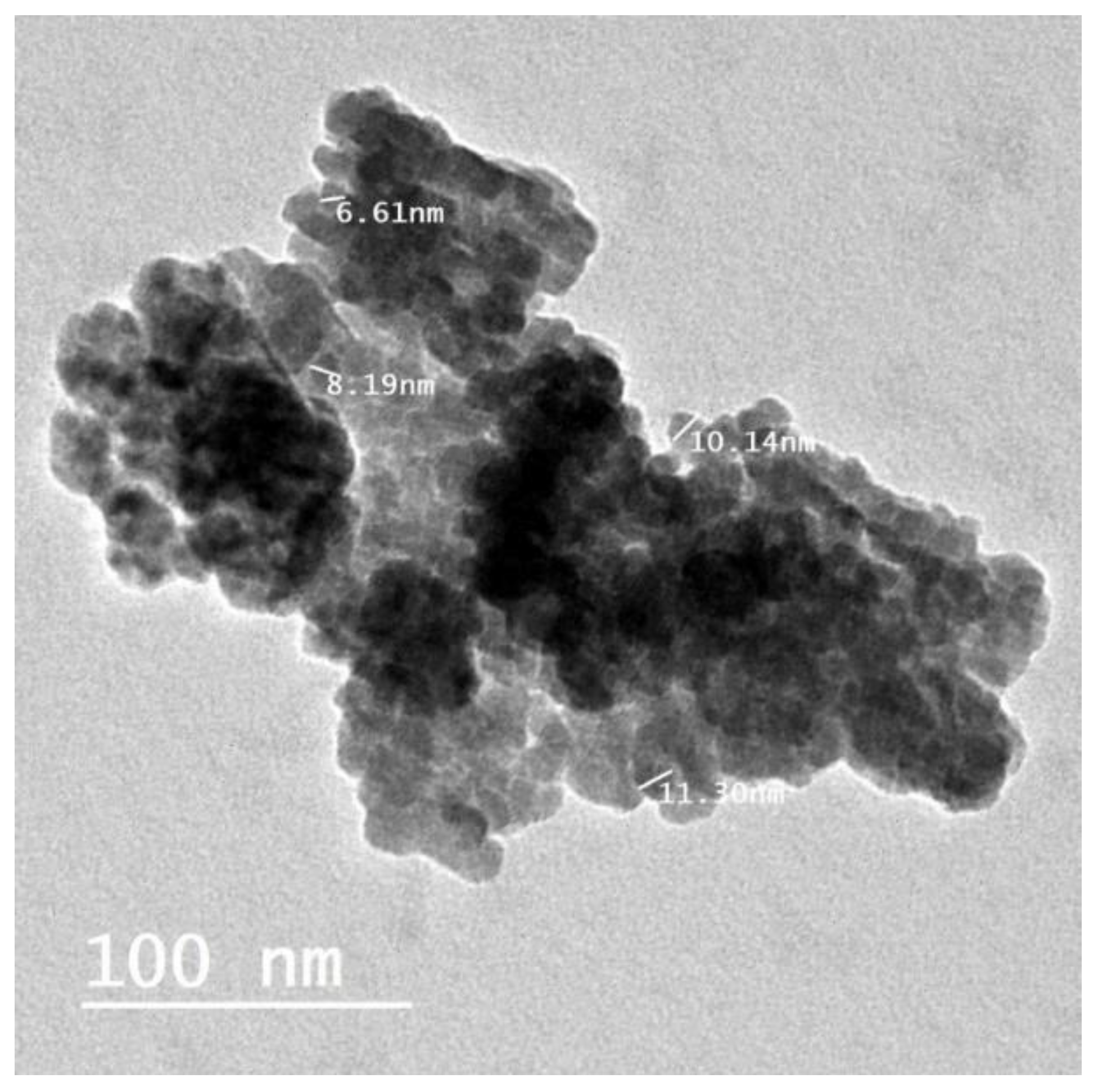
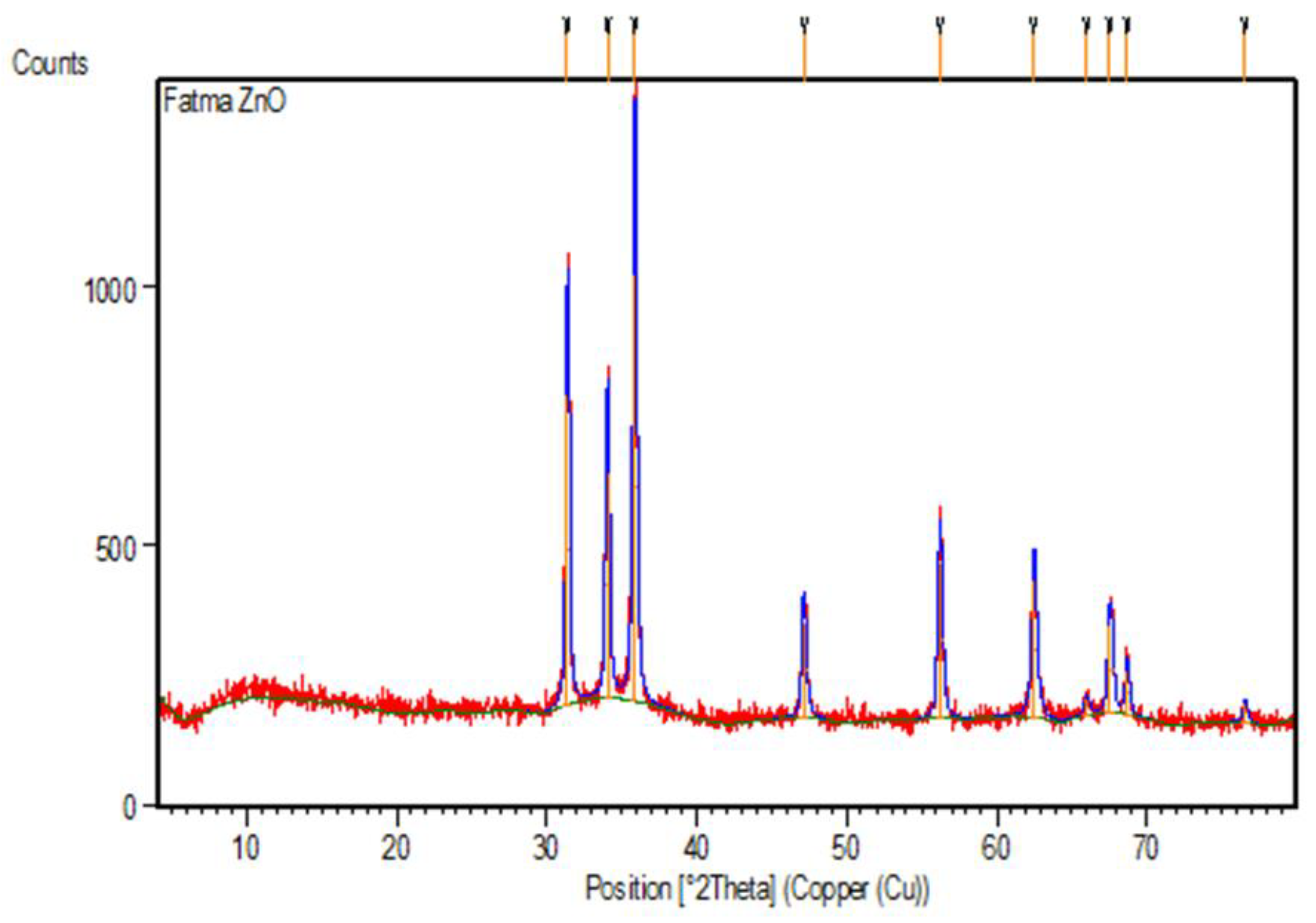


| ZnO NPs | Maesa indica Ethanolic Extract | ||||
|---|---|---|---|---|---|
| No. | The Band | The Corresponding Function Group | No. | The Band | The Corresponding Function Group |
| 1. | 3417.86 cm−1 | O-H group | 1. | 3417.86 cm−1 | O-H of alcoholic compound |
| 2. | 3934.78 cm−1 | O-H stretching | 2. | 2927.94 cm−1 | O-H of carboxylic acid compounds |
| 3. | Essam M. Abd el kaderi 2283.72 cm−1 | C-C triple bond of alkynes | 3. | 2860.79 cm−1 | O-H of carboxylic acid compounds |
| 4. | 1897.96 cm−1 | C=O stretching of carboxylic group | 4. | 2430.31 cm−1 | C-H of alkane group |
| 5. | 1801.51 cm−1 | C=O stretching of carboxylic group | 5. | 2330.87 m−1 | |
| 6. | 1577.77 cm−1 | C=C stretching of cyclic alkene | 6. | 2341.58 m−1 | |
| 7. | 1411.89 cm−1 | O-H bending of carboxylic group | 7. | 2167.99 cm−1 | C-C triple bond of alkynes |
| 8. | 1384.89 cm−1 | 8. | 1924.96 cm−1 | C-H bending of aromatic compound | |
| 9. | 1265.30 cm−1 | C-O of alcohols and carboxylic acid esters | 9. | 1870.95 m−1 | |
| 10. | 1184.29 cm−1 | 10. | 1635.64 cm−1 | CH bending and in cycle C-C or stretching of C=O in the phenolic components | |
| 11. | 1014.56 cm−1 | 11. | 1516.05 m−1 | ||
| 12. | 887.26 | C-H bending | 12. | 1451.33 m−1 | |
| 13. | 439.77 | ZnO NPs band | 13. | 1384.89 cm−1 | |
| 14. | 416.62 cm−1 | 14. | 1269.16 cm−1 | C-O stretching of aromatic ester compound | |
| 15. | 1230.58 cm−1 | C-O stretching of aromatic ester compound | |||
| 16. | 1114.86 cm−1 | C-O of secondary alcohol compound | |||
| 17. | 1080.14 cm−1 | ||||
| 18. | 1053.13 cm−1 | C-H of alkanes group | |||
| 19. | 918.12 cm−1 | =CH bending of an alkene group | |||
| 20. | 887.265 cm−1 | ||||
| 21. | 821.68 cm−1 | ||||
| 22. | 775.38 cm−1 | ||||
| Name | Conc. (µg/g) | Q1 (m/z) | Q3 (m/z) | RT (min) | CE (V) | CXP (V) | DP (V) |
|---|---|---|---|---|---|---|---|
| Gallic acid | 10.81 | 168.9 | 124.9 | 3.9 | −30 | −11 | −110 |
| 168.9 | 79 | 3.9 | −30 | −11 | −110 | ||
| Caffeic acid | 33.66 | 178.9 | 135 | 8 | −22 | −9 | −115 |
| 178.9 | 107 | 8 | −30 | −7 | −115 | ||
| Rutin | 2.85 | 609 | 299.9 | 9.7 | −48 | −15 | −230 |
| 609 | 270.9 | 9.7 | −70 | −9 | −230 | ||
| Coumaric acid | 9.79 | 162.9 | 119 | 9.5 | −20 | −7 | −90 |
| 162.9 | 93 | 9.5 | −40 | −5 | −90 | ||
| Vanillin | 18.50 | 151 | 136 | 9.6 | −12 | −9 | −140 |
| 151 | 92 | 9.6 | −16 | −7 | −140 | ||
| Naringenin | 31.99 | 271 | 151 | 15 | −24 | −25 | −130 |
| 271 | 119 | 15 | −34 | −11 | −130 | ||
| Querectin | 1.54 | 301 | 151 | 13.6 | −28 | −9 | −50 |
| 301 | 178.8 | 13.6 | −20 | −7 | −50 | ||
| Ellagic acid | 2.67 | 301 | 145 | 9.9 | −40 | −14 | −120 |
| 301 | 245 | 9.9 | −38 | −14 | −120 | ||
| 3.4−Dihydroxybenzoic acid | 41.79 | 152.9 | 109 | 5.8 | −40 | −5 | −75 |
| 152.9 | 90.9 | 5.8 | −20 | −7 | −75 | ||
| Hesperetin | ND | 301 | 164 | 15.6 | −23 | −10 | −125 |
| 301 | 136 | 15.6 | −38 | −10 | −125 | ||
| Myricetin | ND | 317 | 179 | 11.7 | −19 | −10 | −100 |
| 317 | 137 | 11.7 | −26 | −10 | −100 | ||
| Cinnamic acid | ND | 146.9 | 102.6 | 14.2 | −17 | −6 | −60 |
| 146.9 | 77 | 14.2 | −33 | −6 | −60 | ||
| Methyl gallate | 0.30 | 183 | 124 | 7.5 | −30 | −10 | −110 |
| 183 | 140 | 7.5 | −30 | −10 | −110 | ||
| Kaempferol | 5.23 | 284.7 | 93 | 15.3 | −46 | −10 | −120 |
| 284.7 | 116.8 | 15.3 | −52 | −10 | −120 | ||
| Ferulic acid | 18.51 | 192.8 | 133.9 | 10.2 | −16 | −5 | −25 |
| 192.8 | 177.9 | 10.2 | −12 | −5 | −25 | ||
| Syringic acid | 12.77 | 196.9 | 122.8 | 8.4 | −24 | −5 | −30 |
| 196.9 | 181.9 | 8.4 | −12 | −5 | −30 | ||
| Apigenin | ND | 269 | 151 | 15 | −15 | −7 | −35 |
| 269 | 117 | 15 | −15 | −7 | −35 | ||
| Catechin | ND | 288.8 | 244.9 | 7.3 | −16 | −8 | −40 |
| 288.8 | 109 | 7.3 | −32 | −8 | −40 | ||
| Luteolin | 8.39 | 284.7 | 132.9 | 13.5 | −38 | −10 | −50 |
| 284.7 | 150.9 | 13.5 | −26 | −10 | −50 | ||
| Chlorogenic acid | 1803.84 | 355.1 | 163 | 7.8 | 21 | 10 | 46 |
| 355.1 | 89 | 7.8 | 75 | 14 | 46 | ||
| Daidzein | ND | 255.1 | 199 | 13.4 | 28 | 10 | 125 |
| 255.1 | 91.1 | 13.4 | 44 | 10 | 125 |
| The Sample | CC50 | IC50 | SI | Unit |
|---|---|---|---|---|
| ZnO nanoparticles | 292.61 ± 0.93 | 7.15 ± 0.10 | 40.92 | µg/mL |
| ZnO NPs combined with ME | 138.49 ± 0.26 | 5.23 ± 0.18 | 26.47 | µg/mL |
| 70% ME | 235.94 ± 0.32 | 9.97 ± 0.38 | 23.66 | µg/mL |
| Rate | Holding Time by Min. |
|---|---|
| 2% acetonitrile (LC grade) | 0−1 min |
| 2−60% acetonitrile (LC grade) | 1−21 min |
| 60% acetonitrile (LC grade) | 21−25 min |
| 2% acetonitrile (LC grade) | 25.01−28 min |
Disclaimer/Publisher’s Note: The statements, opinions and data contained in all publications are solely those of the individual author(s) and contributor(s) and not of MDPI and/or the editor(s). MDPI and/or the editor(s) disclaim responsibility for any injury to people or property resulting from any ideas, methods, instructions or products referred to in the content. |
© 2023 by the authors. Licensee MDPI, Basel, Switzerland. This article is an open access article distributed under the terms and conditions of the Creative Commons Attribution (CC BY) license (https://creativecommons.org/licenses/by/4.0/).
Share and Cite
Abdelgawad, F.A.M.; El-Hawary, S.S.; Abd El-Kader, E.M.; Alshehri, S.A.; Rabeh, M.A.; El-Mosallamy, A.E.M.K.; El Raey, M.A.; El Gedaily, R.A. Phytochemical Profiling and Antiviral Activity of Green Sustainable Nanoparticles Derived from Maesa indica (Roxb.) Sweet against Human Coronavirus 229E. Plants 2023, 12, 2813. https://doi.org/10.3390/plants12152813
Abdelgawad FAM, El-Hawary SS, Abd El-Kader EM, Alshehri SA, Rabeh MA, El-Mosallamy AEMK, El Raey MA, El Gedaily RA. Phytochemical Profiling and Antiviral Activity of Green Sustainable Nanoparticles Derived from Maesa indica (Roxb.) Sweet against Human Coronavirus 229E. Plants. 2023; 12(15):2813. https://doi.org/10.3390/plants12152813
Chicago/Turabian StyleAbdelgawad, Fatma Alzahra M., Seham S. El-Hawary, Essam M. Abd El-Kader, Saad Ali Alshehri, Mohamed Abdelaaty Rabeh, Aliaa E. M. K. El-Mosallamy, Mohamed A. El Raey, and Rania A. El Gedaily. 2023. "Phytochemical Profiling and Antiviral Activity of Green Sustainable Nanoparticles Derived from Maesa indica (Roxb.) Sweet against Human Coronavirus 229E" Plants 12, no. 15: 2813. https://doi.org/10.3390/plants12152813
APA StyleAbdelgawad, F. A. M., El-Hawary, S. S., Abd El-Kader, E. M., Alshehri, S. A., Rabeh, M. A., El-Mosallamy, A. E. M. K., El Raey, M. A., & El Gedaily, R. A. (2023). Phytochemical Profiling and Antiviral Activity of Green Sustainable Nanoparticles Derived from Maesa indica (Roxb.) Sweet against Human Coronavirus 229E. Plants, 12(15), 2813. https://doi.org/10.3390/plants12152813






